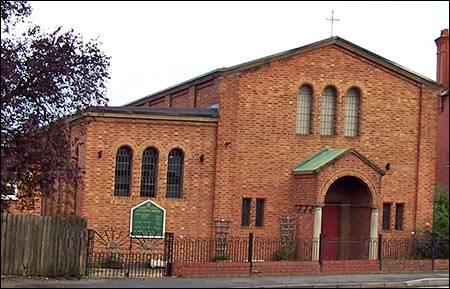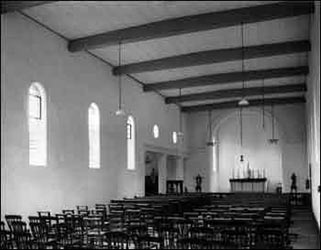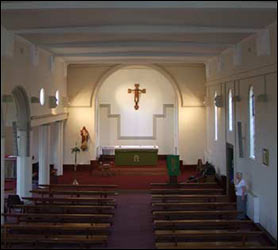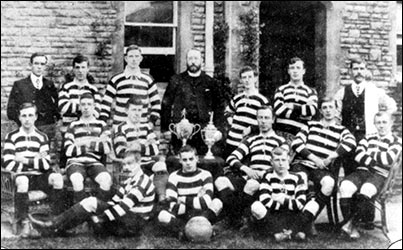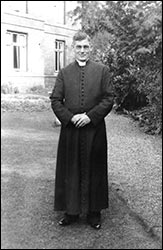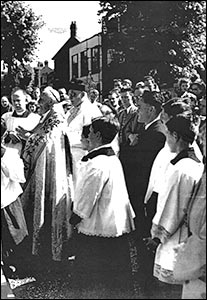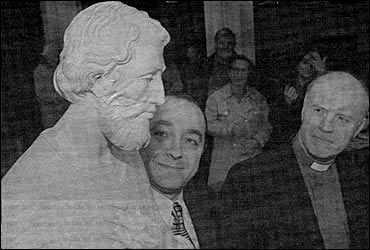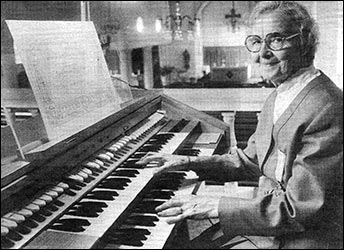|
|||||||||||||||||||||||
|
St. Peter the Apostle Roman Catholic Church
|
|||||||||||||||||||||||
|
History
|
|||||||||||||||||||||||
|
|||||||||||||||||||||||
|
|||||||||||||||||||||||
|
By 1868 at the latest Robert Wigram Arkwright and his family had moved to Knuston Hall and Mass was being said there every other Monday. According to Father Murray it was Mrs. Arkwright who wrote to Bishop Amherst and asked him to send a priest to say Mass for the Catholics at Wellingborough and promised to contribute £50 a year towards expenses. It would appear that Mrs. Akwright had an Oratory in Knuston Hall which seemed to have originated in the time of Bishop Amherst. On 25th September 1880 Bishop Riddell entered in his log book ‘Bishop inspects Oratory at Knuston.’ Nowhere is there any reference to Mass being said at Knuston. On 28th August 1899 Father Murray placed £10.15.0 in the Bishop's hands and after Mrs. Arkwright’s death in 1898 a list of things left by her for Rushden was announced. The list of things included – an oak altar, a tabernacle and candlesticks etc. Complete furnishings for an Oratory. Rushden was a daughter mission of Wellingborough and in 1899 the Presbytery was commissioned along with a portion of the church – the present Sacristy. On 4th March 1890 £300 for building purposes was handed to the Bishop by Father Murray.
All the present church grounds were acquired by Mr. Charles Berrill early in the twentieth century. He bought the grounds when it was difficult for Catholics to acquire land for church buildings. Charles was inspired to become a Roman Catholic by a friend he regularly took to Sunday Mass. Already a Catholic he married Emily, a Catholic from Irchester. In 1900 Father Murray drew up a list of 116 Catholics in the Rushden and Irthlingborough area. On 6th February 1901 a plot of land at the junction of Hayway and High Street (the site of the present church) was conveyed to Father Murray by T. Lilley, W.B. Skinner and A. Sykes. Father Murray, in turn, conveyed the land to the Diocesan Trustees on 2nd March. The plot had a frontage to the High Street of 190 ft. and a frontage to the Hayway of 63 ft. an area of 2020 sq. yds. and was purchased at 7/6 per sq. yd. On 15 April 1902 the Bishop entered in his Log Book ‘Bishop considers plan of plot at Rushden.’ Father James Shore was born in Kilkenny, Ireland in 1856, was educted in Ireland and ordained priest for the Diocese of Mauritius in 1879. There is some confusion about his career after leaving Mauritius, one source saying that he came to the Diocese of Northampton in 1897. He is also said to have started a Mission at Bishop’s Stortford in 1900. However, what is certain is that he came as a Chaplain to Baylis House School, Stoke Poges, Bucks in 1900. He left the school towards the end of 1901 and went to Ireland, arriving back at Northampton at the end of May 1902. On 30th May 1902 Father James Shore arrived from Ireland. On 17th June 1902 the Bishop, Father Murray and Father Shore went to Rushden to inspect the land. On 20th June the Bishop had a meeting with Mr. Hull, the architect. At this stage the plan was to build a section, 35 ft by 24 ft, part of the nave of the future church but on 22nd August 1902 the Bishop agreed to rent 4 Alfred Street, Rushden at a rent of £20 per annum. It would therefore appear that the Bishop was unsure about the future plans. On 31st August 1902 the Mission was opened by Father Shore at 4 Alfred Street when 27 people were present at Mass. On 7 September the Bishop went over and celebrated Mass in the new chapel but on 2nd January 1903 Father Shore wrote to the Bishop to say that there had been only 9 people at Mass on Christmas Day and only 7 at Mass the previous Sunday. In November 1903 Father Shore left Rushden and the Diocese apparently in poor health. He was followed by Father Eugene O’Hagan, born in Liverpool in 1870, who came to Rushden from Stowmarket in 1903.
On 29th August 1904 the Bishop entered in his Log Book; ‘Called on Mr. Hull and authorised him to get tenders for the chapel at Rushden (estimated by him to cost £300). On 26th September the Bishop called on Mr. Hull – opened tenders for Rushden – lowest £402. On 4th October the Bishop again called on Mr. Hull and directed him to submit new plan for Rushden and to authorise Mr. Swindall to erect Rushden Chapel and Sacristy for £332. Authorised the building by Mr. Swindall of chapel at Rushden for £332 and £70 for fencing. (Mr. Hull was a William Hull of St. Giles’s, Northampton, Mr. Swindall was a local builder).
St. Francis Magazine. April 1909. The Sunday School under the direction of Mrs. Barron assisted by Miss Lily Flavist is well attended. As there is no Catholic Day School in the town the labours of these two ladies cannot be overrated and a large debt of gratitude is already due to them by the parents of the children for the work they have done. St. Francis Magazine. July 1910. A great improvement has been affected in the appearance of the little chapel here through the generosity of Mr. Joseph Carter of Kimbolton who has recently given a pair of handsome brass brackets and hangings for the service and adornment of the altar. Father O'Hagan was succeeded by Father Waldie, born 15th July 1865 at Oxford. He was only at Rushden until his death on 18th September 1911. He was succeeded by Rev. Dr. Thomas O’Gorman in 1911 who remained there until 1917 when he returned to Ireland. A nicely designed baptismal font was erected to perpetuate the memory of Father Waldie. St. Francis Magazine. January 1915. On 12th November a Whist Drive and Dance, organised by the Catholics of Rushden was held at the Co-operative Hall for the benefit of the local Belgian Relief Fund. Their effort was well supported by the non-catholics of the town and though there happened to be a fascinating counter attraction in the town on the same night still the handsome profit of £9.6.0 was realised on the project. The arrival of about ninety Belgian refugees in the Rushden district as well as some wounded British soldiers at Hinwick House has, owing to the smallness of the church, necessitated the celebration of a second Mass on Sundays at Rushden. When thirty refugees came to Raunds, a village six miles from Rushden, the Raunds Belgian Refugee Committee, on the suggestion of Father O’Gorman, asked the Wellingborough Bus Co. to send a special free bus on Sundays to convey the refugees to Mass. The Bus company met their request most favourably. They could not send a bus on Sundays as they wished to give their own men a rest and also an opportunity to go to church, but they guaranteed a weekly contribution of 10s for the hire of a conveyance. This sum almost covers the expenditure of the conveyance. The deficit is being supplied by the Raunds Belgian Relief Committee. Father Frederick William Lockyer came to Rushden in 1917. He was born in Southampton on 12th June 1883 and was a convert. He remained in Rushden until 1924 when he moved to Kettering. He was succeeded by Father Frederick Charles Nutt who was born in Oxford on 28th November 1890 and stayed until 1937.
Tablet. 19th June 1926. A cheerful hall, with seating capacity of 300, was opened at Rushden on 9th June by the Bishop of Northampton. Father Nutt, the Rector, made a speech in which he dwelt upon the friendliness of non-catholics to himself and his people. St. Francis Magazine. October 1926. A new Parish Hall adjoining the church in Rushden was opened lately by the Bishop who congratulated the parish priest, Father F.C. Nutt and his helpers on completing the building in so short a time. The Hall is 60 feet by 25 and can seat 300 persons. All the decorating and painting was done by parishioners. An enjoyable musical programme, which followed the opening, included songs by Miss Millicent Childs, Miss Floss Pearson and Mr. T. Lilley. Mr. John W. Cooke and his orchestra played also for a well attended dance, over which Mr. T. Bateman who had done much organisation work, was M.C. The Bishop congratulated Fr. Nutt and his fellow workers; they had shown what could be done even by a few people. When those people were united by one will and strong determination, things must ‘come off’. They had shown, too, that one need never be half hearted and despondent as long as there was goodwill and courage behind an effort. But it did not end there; the goodwill, the power, courage, energy and science displayed, could not be allowed to rest now the thing was done. He would rely on them with absolute confidence to continue and increase in power and enthusiasm along with the enthusiasm of their priest. In later years the Hall was used for Mass on Sundays, when the congregation was too large for the Chapel, until the opening of the new Church. On 6th November 1955 Bishop Parker laid the Foundation Stone of a new church designed by J.S. Comper. F.R.I.B.A. in which the former chapel was incorporated as a sacristy. On 27th May 1956 the new church was solemnly blessed and opened by Bishop Parker.
Father John Harris was parish priest from 1965 to 1976 followed by Father Neville McClements from 1976 to 1980 then Canon Brian Frost. In 1991 Fr. Roger Edmunds became parish priest until 1994. From 1994 until 1995 it was Father Anthony Hogarth then from 1995 to date Father Joe Walsh. In March, 1972 St. Peter’s Parish Social Club was opened and made deliberately in two parts. The hall was to be used for all kinds of functions and meetings and there was a licensed club where members could socialise with their friends.
|
|||||||||||||||||||||||
